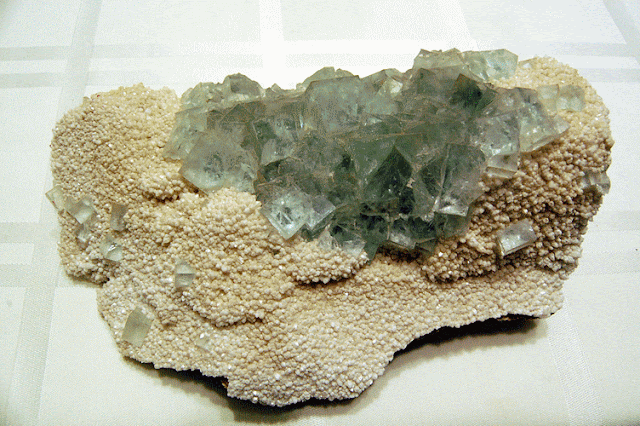Fun With Ultraviolet
Recent visits to the New Jersey Mineral, Fossil, Gem, and Jewelry Show have increased my interest in fluorescent minerals. I've obtained three different ultraviolet lamps, purchased fluorescent specimens, and collected a few fluorescent rocks near home. My newest acquisition is a small, powerful, longwave (LW) ultraviolet flashlight whose peak output wavelength is centered on 365 nanometers. This new UV lamp is great for exciting fluorite. The first picture below shows green fluorite crystals as they appear in ordinary light. The second image below shows the same crystals fluorescing blue when illuminated with the LW UV light.
The effect is quite dramatic.
LW UV also caused nearly transparent calcite to fluoresce pink, but I couldn't find a way to properly capture this in a photo.
I had lots of fun inspecting our dark, nighttime house with the UV flashlight. It revealed dust and tiny threads on everything! Dust that's normally invisible in ordinary light glows like white snow in UV. Surfaces that looked clean in ordinary light were shown to be disturbingly splotched and splattered in UV. For example, plastic place mats and kitchen stove controls were amazingly blemished. Green leaves on one of our houseplants glowed red when lit by UV.
Illumination with higher energy shortwave (SW) UV is considerably more spectacular than illumination with lower energy LW UV, at least with minerals in my collection. My SW UV lamp produces 254 nanometer UV. This creates some wonderful fluorescent effects. Look at the geode in the next picture below as it appears in ordinary light. Compare it with the same geode fluorescing in SW UV in the second picture.
Electrons in these fluorescing minerals exist in complicated arrangements of discrete energy levels, as if they were sitting on steps of a staircase with varying step heights. Electrons on higher steps have higher energy than electrons on lower steps. When the mineral is illuminated with UV light, electrons gain energy from the UV light and jump up the staircase by many steps at once. Eventually, the excited, bumped up electrons will fall down stairs to lower energy again, but, when they fall down, they can do so by dropping in smaller steps than the original larger, ultraviolet-induced, multistep upward jump. As electrons lose energy by falling down smaller step sizes, they emit lower energy visible light which we see as fluorescence. The energy of visible light photons ranges from red, at 1.77 electron volts (ev), to violet at, 3.10 ev. The energy of a single LW UV photon is 3.40 ev, while a SW UV photon has an even greater energy of 4.88 ev. It's as if visible light comes from jumps between stairs 1.77 to 3.10 feet high, while UV light can kick electrons up through heights of 3.4 or 4.88 feet.
The next two pictures show a small geode recently purchased at the 2018 rock show. The first picture is in ordinary light. The second picture is in SW UV light.
Fluorescent effects appear much more vivid to the naked eye than they appear in these photos. (The opposite held true when photographing auroras.) Fluorescence is, obviously, stronger and more widespread when the UV light source is positioned very close to the specimen, but the UV lamp then blocks the camera's view. I will soon purchase a more powerful SW UV light source which will, I hope, create spectacular fluorescence from a greater distance.
One of the strongest fluorescent minerals in my collection is hardystonite. It looks like an unremarkable rock in ordinary light in the first picture below, but explodes in red and green fluorescence in SW UV as you can see in the second picture below.
Another fluorescing champion is the chunk of calcite and willemite shown in the next two images. Calcite fluoresces red, the willemite fluoresces green.
The green area on the right hand side of the previous picture continues glowing after UV is removed! This is an example of phosphorescence.
Finally, the next two pictures show a driveway stone from a local construction site. Fluorescence increases as the UV light is brought closer to the sample, and yellow specks on the lower left side are more intense and golden to the naked eye than the second photo shows.
I love the colorful way ultraviolet light reveals surprising hidden beauty in minerals.
Subscribe to:
Post Comments (Atom)
People say I'm crazy doing what I'm doing
Well they give me all kinds of warnings to save me from ruin
When I say that I'm o.k. well they look at me kind of strange
Surely you're not happy now you no longer play the game
People say I'm lazy dreaming my life away
Well they give me all kinds of advice designed to enlighten me
When I tell them that I'm doing fine watching shadows on the wall
Don't you miss the big time boy you're no longer on the ball
I'm just sitting here watching the wheels go round and round
I really love to watch them roll
No longer riding on the merry-go-round
I just had to let it go
John Lennon















No comments:
Post a Comment